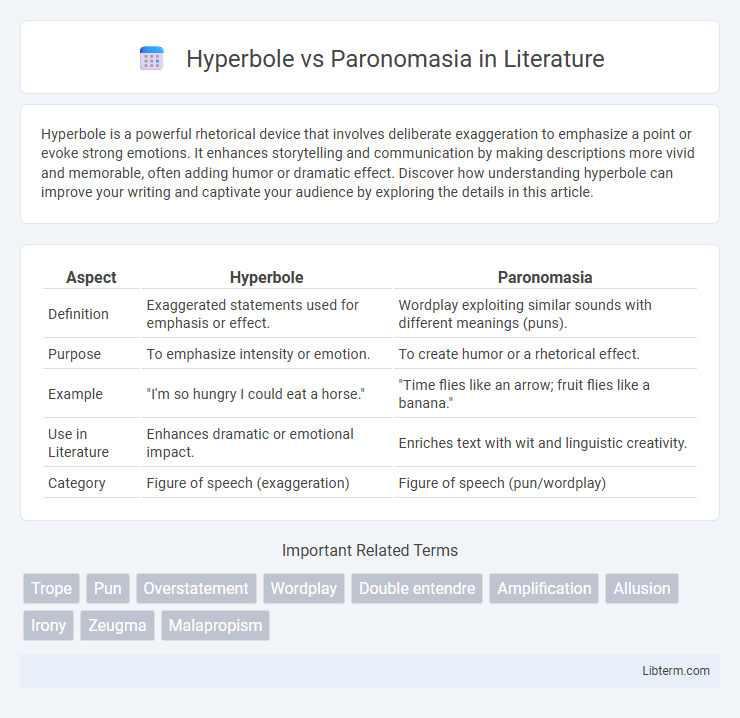Hyperbole is a powerful rhetorical device that involves deliberate exaggeration to emphasize a point or evoke strong emotions. It enhances storytelling and communication by making descriptions more vivid and memorable, often adding humor or dramatic effect. Discover how understanding hyperbole can improve your writing and captivate your audience by exploring the details in this article.
Table of Comparison
| Aspect | Hyperbole | Paronomasia |
|---|---|---|
| Definition | Exaggerated statements used for emphasis or effect. | Wordplay exploiting similar sounds with different meanings (puns). |
| Purpose | To emphasize intensity or emotion. | To create humor or a rhetorical effect. |
| Example | "I'm so hungry I could eat a horse." | "Time flies like an arrow; fruit flies like a banana." |
| Use in Literature | Enhances dramatic or emotional impact. | Enriches text with wit and linguistic creativity. |
| Category | Figure of speech (exaggeration) | Figure of speech (pun/wordplay) |
Introduction to Hyperbole and Paronomasia
Hyperbole is a rhetorical device that involves exaggerated statements or claims not meant to be taken literally, often used to create emphasis or evoke strong feelings. Paronomasia, commonly known as a pun, is a form of wordplay that exploits multiple meanings of a term or similar-sounding words for humorous or rhetorical effect. Both hyperbole and paronomasia serve distinct functions in language, enriching text by intensifying expression and engaging the audience through creativity.
Defining Hyperbole: Exaggeration in Language
Hyperbole is a figure of speech that involves deliberate exaggeration to emphasize a point or evoke strong feelings, often making descriptions more vivid and impactful. Paronomasia, or punning, plays on the similarity of sounds between words with different meanings to create humor or a rhetorical effect. Unlike paronomasia, hyperbole relies on amplifying the truth beyond reality rather than exploiting wordplay.
Understanding Paronomasia: The Art of Wordplay
Paronomasia, commonly known as a pun, is a form of wordplay that exploits the similarity in sound between two or more words to create humor or rhetorical effect, distinguishing it from hyperbole, which relies on exaggerated statements for emphasis. Understanding paronomasia involves recognizing phonetic ambiguity and double meanings that engage listeners or readers by prompting them to interpret multiple possible meanings simultaneously. This linguistic technique enhances communication by adding wit and layers of meaning, making it a powerful tool in literature, advertising, and everyday conversation.
Key Differences Between Hyperbole and Paronomasia
Hyperbole is a figure of speech that involves deliberate exaggeration to create emphasis or effect, often amplifying facts beyond reality for dramatic impact. Paronomasia, commonly known as a pun, relies on wordplay by exploiting multiple meanings or similar sounds of words to produce a humorous or rhetorical effect. The key difference lies in hyperbole's emphasis on exaggeration for intensity, whereas paronomasia centers on linguistic ambiguity and sound similarity for wit or humor.
Common Examples of Hyperbole in Everyday Speech
Hyperbole commonly appears in everyday speech through exaggerated phrases like "I'm so hungry I could eat a horse" or "This bag weighs a ton," which emphasize feelings or situations beyond literal truth for dramatic effect. Paronomasia, in contrast, relies on wordplay through puns, such as "Time flies like an arrow; fruit flies like a banana," exploiting similar sounds for humor or rhetorical impact. Understanding hyperbole involves recognizing its use in amplifying expressions to convey strong emotions or impressions, a frequent device in casual conversations and storytelling.
Popular Instances of Paronomasia in Literature
Paronomasia, a form of wordplay exploiting similar sounds of words with different meanings, appears prominently in Shakespeare's works, such as the pun on "grave" in *Romeo and Juliet*, highlighting the dual meaning of seriousness and a burial site. Edgar Allan Poe employs paronomasia in "The Bells" to mimic the ringing sounds, enhancing thematic elements through phonetic repetition. This rhetorical device enriches literary texts by introducing humor, irony, or emphasis, distinguishing it from hyperbole, which relies on deliberate exaggeration for effect.
Impact of Hyperbole and Paronomasia on Communication
Hyperbole amplifies communication by exaggerating facts to evoke strong emotional responses, making messages more memorable and persuasive. Paronomasia leverages phonetic similarity of words to create witty, playful effects that engage audiences and enhance linguistic creativity. Both devices enrich language, with hyperbole emphasizing emotional intensity and paronomasia highlighting verbal cleverness for impactful communication.
Hyperbole vs Paronomasia in Creative Writing
Hyperbole enhances creative writing by employing exaggerated statements that evoke strong emotions and vivid imagery, making narratives more impactful and memorable. Paronomasia, or wordplay involving similar-sounding words, introduces humor and wit, enriching the text with linguistic creativity and engaging readers through clever associations. Combining hyperbole with paronomasia allows authors to craft dynamic, playful, and expressive prose that captivates audiences through intensified meaning and inventive language use.
Tips for Using Hyperbole and Paronomasia Effectively
To use hyperbole effectively, emphasize exaggeration to create strong emotional impact without confusing the audience by maintaining clear context. Paronomasia works best when witty wordplay balances cleverness and clarity, ensuring the pun enhances the message rather than distracts. Combining vivid imagery in hyperbole with the playful ambiguity of paronomasia engages readers and reinforces key ideas memorably.
Conclusion: The Power of Figurative Language
Hyperbole and paronomasia both amplify meaning through imaginative expression, enhancing communication by evoking strong emotional responses and memorable wordplay. Hyperbole exaggerates for emphasis, creating vivid imagery that captures audience attention, while paronomasia uses puns to engage intellect and wit, making language more dynamic. Mastering these figurative devices unlocks the power to persuade, entertain, and leave a lasting impression in writing and speech.
Hyperbole Infographic

 libterm.com
libterm.com